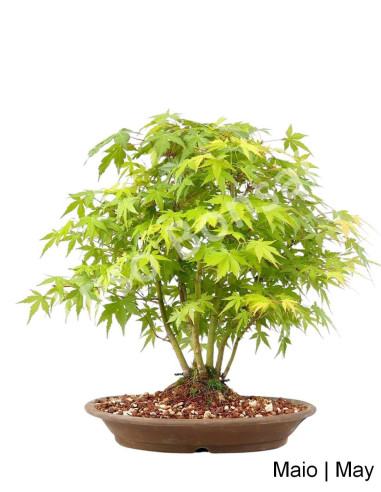- -10%
Acer Palmatum SPP 21-year Bonsai
A species of the family of Aceráceaes, from Japan.
It is a caduca leaf tree, with five lobes (palmatum), being perhaps the most known and appreciated caduca in Bonsai.
Taking into account the multiplicity of varieties and their hybrids, sometimes some varieties that are not identified are classified with spp, this clasification (or absence of it, in no way devalues the plant).
Acer Palmatum spp Bonsai is an outdoor plant.
Scientific name: Acer Palmatum
Characterization: Member of the Acerácea family, from Japan.
Caduca leaf tree, with five lobes (palmatum), is perhaps the best known and appreciated caduca in Bonsai.
There are many varieties used for Bonsai, with the most different colors and sheet dimensions. The best known and appreciated is the "Deshojo", by its red tone on the bud, which becomes greenish in summer returning again to the red tones in the fall of the leaf.
Also the varieties "Yatsubusa" (Palmatum Kashima or Kihoime), are greatly appreciated by the small size of their leaf and short between us, which make quite compact plants, being usually produced in Hokidashi style (round cup), because they do not have apical dominance, and thus their energy becomes more balanced.
Location: Outside, where take 2 to 3 hours of direct sun per day (ideal in the morning or late afternoon), protected from strong winds and frosts.
It is very resistant, but it is usual in the middle of the summer the leaves appear burned from the sun, so we must protect them from the very strong sun of the noon, practically all the summer season.
Watering: To water abundantly the earth until a lot of water goes out through the drain holes in order to moisten evenly the soil, always above never by immersion, with a fine drain waterer SPECIFIC EXISTS FOR BONSAI.
Let slightly dry the surface layer of the soil between each watering (to confirm if the plant already needs water, touch the earth with the fingers), but to pay attention because water consumption increases a lot when in spring it has a lot of new leaf.
If you have a dish under Bonsai, never leave any water in it (to prevent the roots from rotting).
There is no advantage in spraying the leaves, just do it in the days when it adds up and if the fertilizer goes for foliar application, but ensure that they arrive dry at night to avoid fungi.
Nutrition: From February to September/October, with a base plan composed of a complete fertilizer (FERTILE BONSAI Humicy, or GREEN & GOLD Organic or BIOGOLD), and a biostimulant (BIO BONSAI Activ), can still be linked with other products in our range.
Detailed information on how to combine these products the rest of our range, or for a more specific nutrition plan, see TECHNICAL PLAN OF COMPLETE NUTRITION.
Poda: The leaf tends to grow and the between us become long in some species. We usually have to control the growth at the beginning of the boom with "Metsumi".
In summer, as long as they are healthy, they can be defoliated to produce a new leaf sprouting, which in addition to lowering, will have better Outonal staining.
Tips on pruning, see the TECHNICAL DATA SHEET.
Transplant: With BONSAI GROUND Fools in February/March, before the beginning of the budding.
Details about transplantation, post transplantation and specific fortifiers that you can use refer to TRANSPLANTE TECHNICAL FICHA.
Scratch: Usually at the end of winter before the sprouting, or in summer with total defoliation.
Indications on padding, see WIRING.
- Habitat
- Outdoor
- Sheet Type
- Deciduous
- Species
- Acer Palm SPP
- Origin
- Japan






































